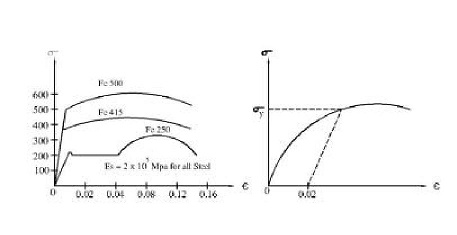Chapter: Civil : Design of Reinforced Concrete Elements : Methods Of Design Of Concrete Structures
Important Question And Answer: Civil - Methods Of Design Of Concrete Structures
1. What are
the assumptions made in the working stress method?
a) At any
cross-section, plane sections before bending remain plain after bending.
b) All
tensile stresses are taken up by reinforcement and none by concrete, except as
otherwise specifically permitted.
c) The
stress-strain relationship of steel and concrete, under working loads, is a
straight line.
d) The
modular ratio m has the value -280/3?bc.
2. Difference
between Elastic method and limit state method.
Advantages of limit state method over the
other methods
a. In the
limit state method of analysis, the principles of both elastic as well as
plastic theories used and hence suitable for concrete structures.
b. The
structure designed by limit state method is safe and serviceable under design
loads and at the same time it is ensured that the structure does not collapse
even under the worst possible loading conditions.
c. The
process of stress redistribution, moment redistribution etc., are considered in
the analysis and more realistic factor of safety values are used in the design.
Hence the design by limit state method is found to be more economical.
d. The
overall sizes of flexural members (depth requirements) arrived by limit state
method are less and hence they provide better appearance to the structure
e. Because
of the modified assumptions regarding the maximum compressive strains in
concrete and steel, the design of compressive reinforcement for double
reinforced beams and eccentrically loaded columns by limit state method gives
realistic valued which is not so in other methods.
3.Draw stress-strain curve for
concrete in working stress design and mention the salient points.

4. Define
characteristic strength in limit state method.
The term 'characteristic strength' means
that value of the strength of the material below which not more than 5 percent
of the test results are expected to fall.
5. What is
meant by balanced section?
When the maximum stress in steel and concrete simultaneously
reach their allowable values, the section is said to be balanced section.in
this section the actual neutral axis depth is equal to the critical neutral
axis.
6. Define :
Limit state".
The acceptable limit for the safety and serviceability
requirements before failure occurs is called a 'limit state'. The aim
of design is td achieve acceptable probabilities that the structure will not
become unfit for the use for which it is intended, that is, that it will not
reach a limit state.
7. What are the expressions recommended by the IS 456-2000 for
Modulus of Elasticity and Flexural Strength?
· lexural
strength f 0.7.fck /mm2
Where 'fck' is the
characteristic cube compressive strength of concrete in N/mm2.
Ec=5000 Rt(fck)
Where, E, is the
short term static modulus of elasticity in N/mm2
8. Write
the formula for the neutral axis depth factor 'K in working stress design.
Neutral axis depth factor 'K' ?bc.m/(?bc.m + ?st)
Where ?bc permissible stress in concrete. ?bc permissible stress in steel.
M = modular ratio.
Related Topics